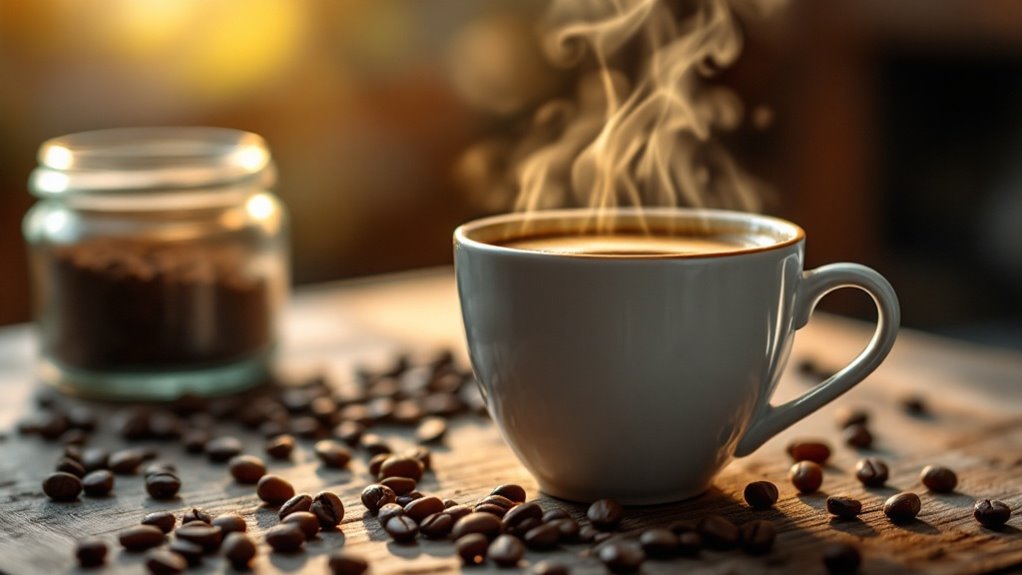







Like a hidden treasure waiting to be discovered, Mexico's coffee culture holds secrets that might surprise you. You'll find that the best coffee here isn't just about the beans but the regions they come from—Chiapas, Veracruz, and Oaxaca each tell a different story through their flavors. Whether it's the nutty richness of Chiapas or the bright complexity of Oaxaca's Pluma Hidalgo, there's a world of taste to explore. But what truly sets Mexican coffee apart? The answer lies in its traditions, sustainability, and the way it's brewed—something you'll want to uncover for yourself.
Key Takeaways
- Chiapas coffee, known for its rich, nutty flavors, is a top choice, contributing over 40% of Mexico's coffee production.
- Oaxaca's Pluma Hidalgo variety offers bright, complex flavors with sweet, chocolatey undertones and a hint of cayenne spice.
- Veracruz coffee, grown in volcanic soil, delivers bold, aromatic profiles with balanced acidity and citrus or spice notes.
- Organic and fair-trade options like Café La Selva and Café El Triunfo highlight sustainable practices and exceptional flavor quality.
- Traditional drinks like café de olla, with cinnamon and piloncillo, showcase Mexico's rich coffee culture and unique flavor profiles.
Overview of Mexican Coffee Growing Regions
While Mexico might be best known for its vibrant culture and cuisine, its coffee-growing regions are equally remarkable, producing some of the world's most distinctive beans. Chiapas, the largest coffee-producing state, contributes 41% of Mexico's national output, with its high-altitude farms yielding beans known for their rich, nutty flavors. Veracruz, the oldest coffee-growing region, benefits from volcanic soil, creating bold, aromatic coffees with balanced acidity. Together with Oaxaca, these regions form the backbone of Mexico's coffee industry, accounting for 80% of production. Each area's unique terroir—shaped by altitude, climate, and soil—imparts distinct characteristics to the beans. Whether you're exploring Chiapas' lush highlands or Veracruz's fertile plains, you'll discover how these coffee-growing regions craft Mexico's reputation as a global coffee powerhouse.
Key Characteristics of Mexican Coffee Beans
Mexican coffee beans, celebrated for their smooth and medium-bodied profile, are primarily Arabica, offering a harmonious balance of acidity and flavor. You'll notice their flavor profile often includes rich notes of chocolate, nuts, and caramel, complemented by subtle citrus or floral undertones. These Arabica beans thrive in high-altitude growing regions, where cooler climates and volcanic soils enhance their brightness and aromatic complexity. Many are shade-grown, a practice that not only deepens their nuanced flavors but also supports sustainable farming. Organic and fair-trade certifications are common, reflecting Mexico's commitment to ethical production. Whether you're savoring a cup from Chiapas, Veracruz, or Oaxaca, you'll experience a coffee that's as vibrant and diverse as the landscapes where it's cultivated.
Top Coffee-Producing Regions in Mexico
Chiapas stands out as Mexico's coffee powerhouse, producing over 40% of the nation's beans, with its high-altitude farms yielding a rich, nutty flavor that reflects the region's Indigenous farming traditions. Oaxaca, on the other hand, offers a distinct profile with its shade-grown varieties like Pluma Hidalgo, which thrives in cloud forests and delivers a bright, complex cup. Both regions showcase the diversity and depth of Mexican coffee, each with its own terroir-driven character.
Chiapas Coffee Highlights
Nestled in the southernmost part of Mexico, the state of Chiapas stands as the country's largest coffee-producing region, accounting for 41% of its total output. Here, coffee thrives at high altitudes, often above 1,200 meters, where volcanic soil and shaded farming methods create a buttery smoothness and balanced acidity. Indigenous communities, representing 85% of Mexico's coffee growers, are the backbone of Chiapas' coffee production, blending traditional techniques with sustainable practices. Their dedication guarantees that much of the coffee is certified organic and fair trade, reflecting both quality and ethical farming. When you sip Chiapas coffee, you'll notice its rich, nutty flavor profile, a hallmark of the region's unique terroir and the meticulous care of its growers. It's a cup that tells a story of heritage and craftsmanship.
Oaxaca's Unique Profiles
While Chiapas may dominate Mexico's coffee production, Oaxaca carves out its own distinct identity with coffees that are as vibrant and diverse as the region itself. Oaxaca's coffee growing thrives in high-altitude farms, ranging from 900 to 1,700 meters, where the cool climate and fertile soil create unique flavor profiles. You'll find bright acidity, floral notes, and hints of chocolate and citrus in every cup. The Pluma Hidalgo variety, a Typica Arabica variant, stands out for its sweet, balanced taste. Traditional, sustainable farming methods guarantee quality, while shade-grown Arabica beans enhance complexity. Oaxaca's coffee culture shines in preparations like café de olla, brewed with cinnamon, piloncillo, and orange peel, offering a sensory journey through its rich heritage and terroir.
Popular Mexican Coffee Brands and Their Profiles
You'll find Café de Olla's traditional charm in its sweet, spiced brew, a hallmark of Mexican coffee culture that combines cinnamon and piloncillo for a uniquely comforting flavor. Brands like Café La Selva and Café Mam highlight Mexico's commitment to organic and fair-trade practices, offering smooth, nuanced profiles with notes of caramel, chocolate, and citrus. Each brand reflects its regional roots, from the rich, nutty undertones of Veracruz to the vibrant, balanced flavors of Chiapas, showcasing the diversity of Mexican coffee.
Café De Olla Tradition
Café de Olla, a beloved Mexican coffee tradition, stands out for its rich blend of cinnamon, piloncillo, and aromatic spices, creating a flavor that's both sweet and deeply spiced. This traditional Mexican coffee is brewed in a clay pot, which infuses the drink with earthy undertones, enhancing its rustic charm. The use of piloncillo, unrefined cane sugar, adds a molasses-like sweetness that balances the bold coffee and warming spices like cloves or orange peel. Often linked to rural and indigenous communities, Café de Olla is more than a beverage—it's a cultural experience, symbolizing warmth and togetherness. Today, pre-packaged versions make it accessible, preserving its authentic essence while inviting you to savor a piece of Mexico's heritage in every sip.
Organic and Fair Trade
As Mexico's coffee culture continues to evolve, organic and fair-trade practices have become central to its identity, reflecting a commitment to sustainability and ethical sourcing. Brands like Café La Selva and Café Mam, both certified organic and fair trade, highlight the rich flavors of Chiapas, offering smooth, caramel-infused profiles or chocolatey notes with citrus undertones. Café El Triunfo, another certified organic and fair-trade option, delivers floral and fruity nuances, while Volcanica Mexican Coffee brings hazelnut-forward blends in versatile grind sizes. Café Montegrande, from Veracruz, emphasizes sustainable farming and direct trade, showcasing berry and spice notes in its medium and dark roasts. These brands not only prioritize environmental stewardship but also guarantee fair wages for farmers, making every sip a reflection of Mexico's dedication to quality and ethics.
Regional Flavor Profiles
While Mexico's coffee landscape is as diverse as its geography, each region's unique terroir and processing methods give rise to distinct flavor profiles that captivate coffee enthusiasts. In Chiapas, beans from Café La Selva and Café Mam deliver smooth, chocolatey notes with hints of citrus and caramel, reflecting the region's fertile highlands. Veracruz, another key coffee-growing region, produces Café Etrusca's rich, full-bodied beans with nutty and chocolate undertones, while Café Montegrande offers complex flavors of berries and spices, thanks to its high-altitude cultivation. Even traditional brews like Café de Olla, with its sweet, spiced profile, showcase how different regions influence taste. Whether you prefer organic, fair-trade, or specialty coffee, Mexico's diverse beans promise a journey through its vibrant coffee-growing regions.
Traditional Mexican Coffee Drinks and Flavors
Traditional Mexican coffee drinks and flavors are deeply rooted in the country's rich culinary heritage, blending indigenous ingredients with colonial influences to create uniquely vibrant beverages. Café de olla, a cornerstone of Mexican coffee culture, brews medium-bodied coffee with cinnamon, piloncillo, and sometimes orange peel, delivering a warm, spiced sweetness. Horchata lattes, a modern twist, combine espresso with the creamy, cinnamon-infused rice drink, offering a revitalizing balance of flavors. Oaxacan chocolate blends, another highlight, infuse coffee with rich, spiced Mexican chocolate, creating a decadent, aromatic experience. These drinks reflect Mexico's diverse growing regions, like Chiapas and Veracruz, where beans often carry notes of chocolate, nuts, and citrus. Seasonal innovations, such as cascara soda, further showcase Mexico's creativity in crafting coffee traditions that honor its cultural roots.
Organic and Fair-Trade Practices in Mexican Coffee
Organic and fair-trade practices have become integral to Mexico's coffee industry, reflecting a commitment to sustainability and social equity. Over 85% of coffee farmers are from indigenous communities, many of whom embrace organic methods, avoiding synthetic pesticides and fertilizers to preserve both their cultural heritage and the environment. In 2012, Mexico became the world's second-largest organic coffee producer, with 17% of its output certified organic. Fair-trade certifications are equally essential, ensuring small-holder producers receive fair wages and adopt sustainable practices. Cooperatives like CESMACH and SICOBI in Chiapas empower indigenous growers, fostering economic stability and environmental stewardship. By choosing organic and fair-trade Mexican coffee, you support a system that values both the land and the people who cultivate it, creating a ripple effect of positive change.
Unique Flavor Profiles of Mexican Coffee
Mexican coffee's flavor profiles are as diverse and vibrant as the landscapes from which they originate, offering a sensory journey shaped by altitude, soil, and tradition. In high-altitude regions like Chiapas and Oaxaca, Mexican coffees often reveal bright, fruity flavors with delicate floral notes, a reflection of the volcanic soil that enriches their growth. Chiapas coffee, for instance, delivers a rich, nutty essence with buttery smoothness, while Oaxacan Pluma Hidalgo surprises with sweet, chocolatey undertones and a hint of cayenne spice. Veracruz coffees, on the other hand, balance bold aromas with citrus and spice, creating a harmonious complexity. Traditional café de olla adds another layer, blending sweet, spiced flavors from cinnamon and piloncillo. Each sip tells a story of Mexico's terroir and heritage.
How to Brew Authentic Mexican Coffee at Home
To brew authentic Mexican coffee at home, you'll want to start with high-quality beans sourced from regions like Chiapas, Veracruz, or Oaxaca, as their unique terroir imparts distinct flavor profiles that range from bright and fruity to rich and chocolatey. For a traditional café de olla, simmer freshly ground coffee with piloncillo, cinnamon sticks, and optional orange peel in a clay pot to infuse the brew with earthy, spiced notes. If you prefer a pour-over, use a medium grind and water heated to 195-205°F (90-96°C) to extract the coffee's nuanced flavors. Experiment with spices like anise or clove for a bold twist. Serve in clay mugs to enhance the aromatic experience, capturing the essence of Mexican coffee culture in every sip.
Exploring Mexico City's Specialty Coffee Scene
As you step into Mexico City's bustling specialty coffee scene, you'll find a vibrant fusion of tradition and innovation, where locally sourced beans take center stage. Coffee shops across the city highlight Mexican-grown beans, often from Oaxaca, showcasing microlots and experimental processing methods that bring out bright, fruity notes. You'll encounter pour-over options, like V60 brews, that emphasize precision and flavor. Many cafes also craft culturally-inspired drinks, blending horchata lattes or Oaxacan chocolate with modern coffee trends. Tasting classes and Q-grader recommendations deepen your appreciation, while Instagram accounts guide you to hidden gems. Whether you're sipping a meticulously brewed filter coffee or indulging in a creative latte, Mexico City's specialty coffee scene offers an unforgettable journey through the country's rich coffee heritage and cutting-edge techniques.
Disclosure: As an Amazon Associate, I earn from qualifying purchases.






